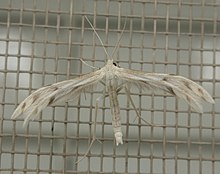|
Wheeleria spilodactylus
Wheeleria spilodactylus, the horehound plume moth, is a moth of the family Pterophoridae, first described by John Curtis in 1827. It is found in South-Western and Central Europe and the Mediterranean, Asia Minor and North Africa. It has been introduced to Australia as a biocontrol agent for white horehound (Marrubium vulgare).[1]   The wingspan is 20–25 millimetres (0.79–0.98 in). Adults are on wing from July to September depending on the location.[2] The difficult to see larvae feed on black horehound (Ballota nigra) and white horehound. References
External links
|
||||||||||||||||||||||||||||||
